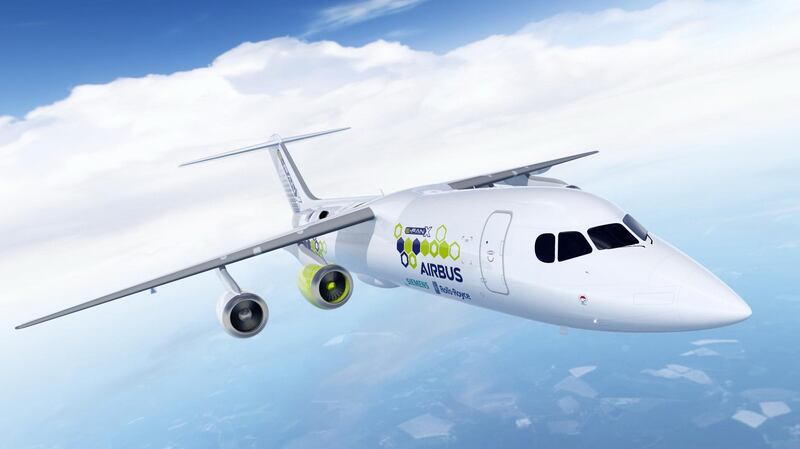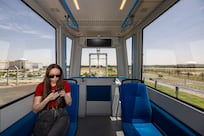The German technology company Siemens and its partner Airbus expect airlines to start using aircraft driven by hybrid electric technology by 2030. This development could then raise questions about the viability of thousands of conventional commercial jets currently in service.
Electric propulsion is expected to become a norm by 2050, although other technologies such as hydrogen-powered aircraft are also being considered, and carriers will be forced to fly new, more cost effective planes to maintain growth, said Johannes Wollenberg, who is part of Siemens' eAircraft team developing hybrid electric propulsion system.
"If they want to grow, they need an alternative to current technology. The only question is doing it with electric or by burning hydrogen," he said.
"Otherwise, we will have stagnation. They [the airlines] want to think about future, they want to think about growth and the growth scenario is only possible if you have disruptive technology."
Siemens and Airbus aim to introduce to the market lower- and middle-power class of "regional aircraft" by 2028, carrying about 100 passengers and driven by hybrid electric propulsion systems, with a power range of up to 8 megawatts. That is enough to power about 5,000 American homes, according to Idaho Public Utilities Commission.
Beyond 2035, the partners plan to have a short-range aircraft such as the A320 operating with a power range of 20MW, Mr Wollenberg said.
The development of a successful hybrid electric propulsion system for commercial use would affect the broader global aviation industry. Carriers around the world will have to consider major investment choices in the future when new hybrid systems come into play. Airlines may have to phase out conventional planes, which cannot be viably altered or retro fitted to accommodate new technologies.
International carriers, including the UAE airlines Emirates, Etihad Airways, flydubai and Air Arabia, have aircraft orders worth hundreds of billions of dollars.
"If we talk about commercial aircraft, this will be a new airplane, retro fitting doesn't make sense," Mr Wollenberg said. "Retro-fitting is really a solution for the general aviation [smaller aircraft] but for commercial aircraft it is not really possible."
Fuel accounts for about half of the total cost of operating an aircraft and Mr Wollenberg said that replacing the conventional combustion engine aircraft with hybrid or electric propulsion would be cost effective.
_______________
Read more:
Norway set to plug in electric passenger planes
Aircraft makers look to spark power revolution for flight
_______________
The A320 accounts for around 70 per cent of the global total passenger kilometres flown - it is the unit of measurement travelled by one passenger by air over a kilometre. "So if we are able to replace the A320 engines with such systems, it's really a huge lever, the biggest lever is in the regional and short-range aircraft," he said.
Air transport currently accounts for 2 per cent of man generated carbon emissions, and aircraft manufacturers are constantly trying to develop more fuel efficient jets to reduce their carbon footprint. Each new generation of plane is on average 20 per cent more fuel efficient than the model it replaces, and over the next decade, airlines will invest $1.3 trillion in new aircraft, according to global industry body International Air Transport Association.
Civil aviation as a whole in 2017 emitted around 859 million tonnes of carbon dioxide. The International Civil Aviation Organisation, a UN agency, in 2016 adopted Corsia, a global carbon offsetting scheme to address CO2 emissions from international aviation. It is expected to help aviation sector offset 2.6 billion tonnes of CO2 between 2021 and 2035. The industry is targeting a 50 per cent reduction in net CO2 emissions by 2050, relative to 2005 levels, according to Iata.
Hybrid aircraft fly on a combination of jet fuel and electric power. At present, battery technology cannot produce a unit light enough or powerful enough to operate an aircraft's electric engines, plus all the other mission-critical systems it requires.
However, with hybrid technology, it is possible to reduce the size of the engine, reduce the fuel burn and enable the aircraft to take off with the combination of jet fuel and electricity. Once the aircraft reaches cruising altitude, the battery will be drained and the aircraft can be flown with a smaller fuel-powered engine.
“This is another level of technology to reduce fuel burn and reduce emission,” Mr Wollenberg said.
Siemens has a "flying testbed" - the German aircraft manufacturer Extra's 330LE aerobatic plane with 1/4MW electric propulsion system, which is a battery-powered aircraft. Together, Airbus and Siemens will produce feasibility studies of various propulsion solutions by 2020. "We have a contract of collaboration, which ends then. There will be a decision on whether Airbus and Siemens work together in the future – may be develop a programme on an aircraft," Mr Wollenberg said.
Electric driving systems are the main domain of Siemens. It is already a big business for the company, and Mr Wollenberg said, the company is fully committed to the development of hybrid electric aircraft propulsion systems.
“Our vision is that by 2050 we will have a real mature technology with which we can replace all [conventional] systems ... in order to reach environmental goals.”







